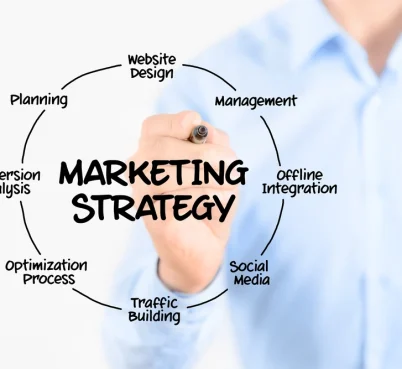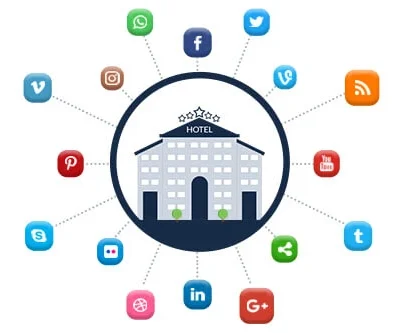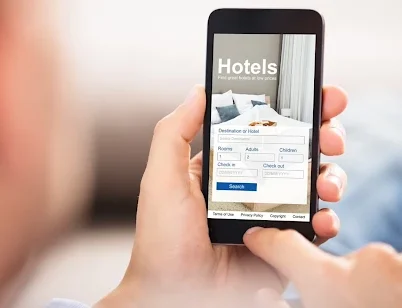There are two types of hotel marketers: those who embrace hotel digital marketing and those who are still clinging to outdated strategies, wondering why their bookings are dropping. The fact is, if your hotel or resort isn’t dominating online, you’re losing out—big time. 82% of travel bookings happen online, and 70% of travelers start on Google. With OTAs in the mix, standing out is tougher than ever. It’s not just about being online—it’s about being found, converting lookers into bookers, and driving loyalty. Let’s dive in our article to see the best digital marketing strategies tailored to your hotel & resort now!
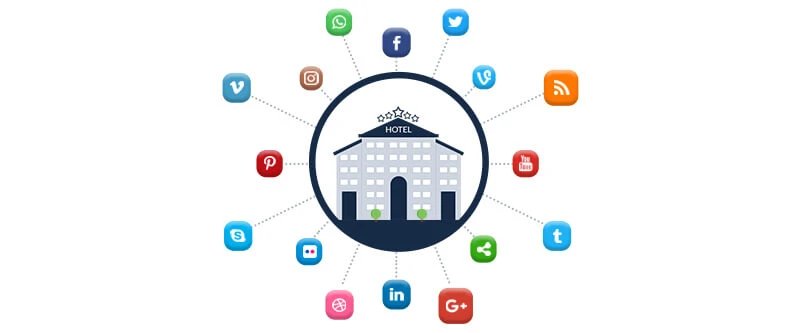
 Beyond functionality, your website should be built for conversion. Clear CTAs (Call-to-Actions), high-quality visuals, and compelling copy make a significant impact on a guest’s decision to book. Adding features like real-time availability, dynamic pricing, and guest testimonials enhances trust and encourages direct bookings.
At the core, a high-converting hotel website is more than just aesthetics—it’s about creating a frictionless, engaging, and conversion-focused experience that turns visitors into paying guests.
Beyond functionality, your website should be built for conversion. Clear CTAs (Call-to-Actions), high-quality visuals, and compelling copy make a significant impact on a guest’s decision to book. Adding features like real-time availability, dynamic pricing, and guest testimonials enhances trust and encourages direct bookings.
At the core, a high-converting hotel website is more than just aesthetics—it’s about creating a frictionless, engaging, and conversion-focused experience that turns visitors into paying guests.
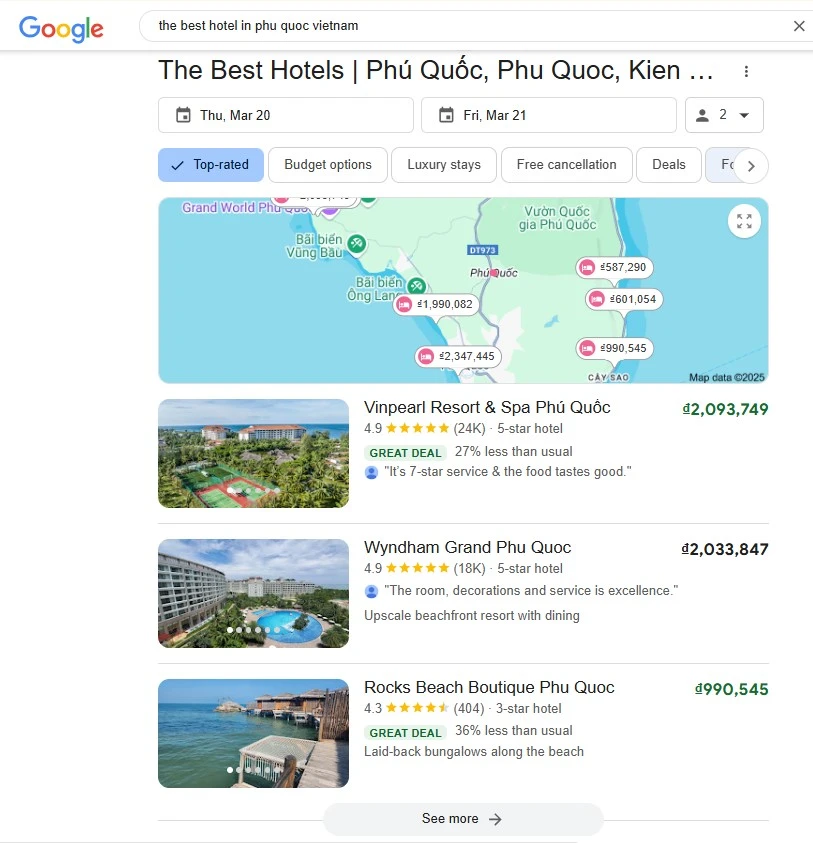 But ranking high on Google isn’t just about stuffing keywords—it requires a combination of technical optimization, high-quality content, and a great user experience. Let’s see key components below:
But ranking high on Google isn’t just about stuffing keywords—it requires a combination of technical optimization, high-quality content, and a great user experience. Let’s see key components below:
Let’s take a look at a case study of Vinpearl Resort & Spa in Vietnam. By optimizing their Google My Business profile with updated photos, descriptions, and guest reviews, launching a blog section and enhancing high-quality backlinks, their organic traffic is placed at top 1 in the tourism industry in Vietnam.
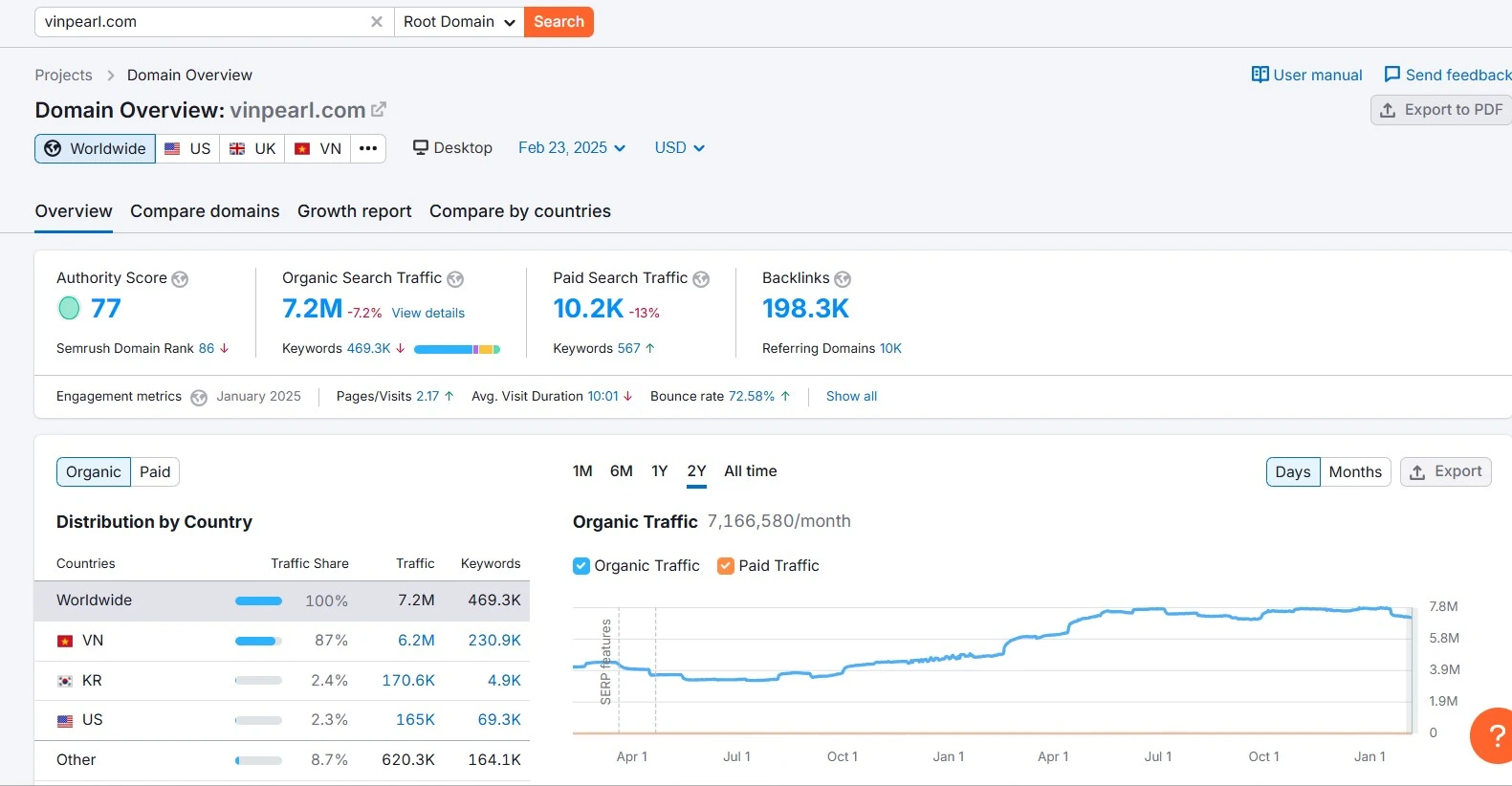 Have you ever wondered how you can leverage SEO to boost direct booking to your website? Learn more at SEO300 Case Studies now! SEO300 is a digital agency established with a view to improving online presences of resorts and hotels in Vietnam. It is ranked Top 3 SEO Agencies by Goodfirms.
Have you ever wondered how you can leverage SEO to boost direct booking to your website? Learn more at SEO300 Case Studies now! SEO300 is a digital agency established with a view to improving online presences of resorts and hotels in Vietnam. It is ranked Top 3 SEO Agencies by Goodfirms.
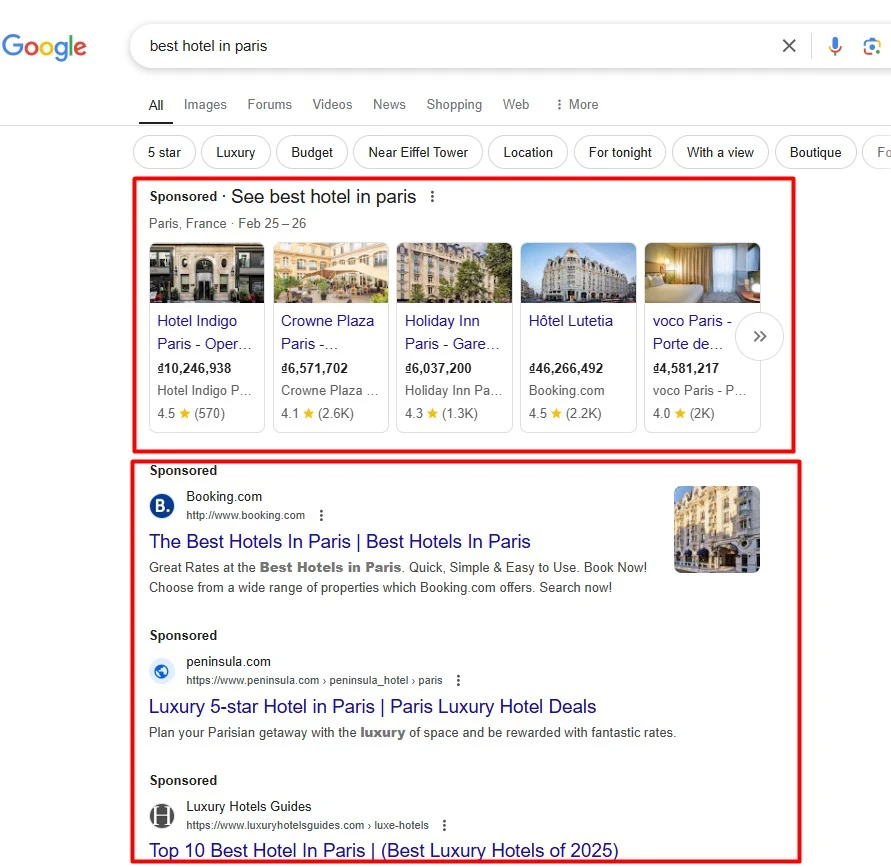 Google Hotel Ads, Search Ads, and Display Ads are among the most effective options, allowing hotels to target high-intent travelers actively looking for accommodations. A well-optimized Google Ads campaign can increase direct bookings by a significant percent, making it a cost-effective alternative to paying OTA commissions .
Budget allocation is crucial. For example, if the cost-per-click (CPC) for “luxury hotel in Paris” is $3, and the average booking value is $500, even a 2% conversion rate results in a 333% return on ad spend (ROAS). Similarly, retargeting ads, which remind users who visited the website but didn’t book, have 10x higher conversion rates than regular display ads, making them an essential strategy for recapturing lost bookings.
Google Hotel Ads, Search Ads, and Display Ads are among the most effective options, allowing hotels to target high-intent travelers actively looking for accommodations. A well-optimized Google Ads campaign can increase direct bookings by a significant percent, making it a cost-effective alternative to paying OTA commissions .
Budget allocation is crucial. For example, if the cost-per-click (CPC) for “luxury hotel in Paris” is $3, and the average booking value is $500, even a 2% conversion rate results in a 333% return on ad spend (ROAS). Similarly, retargeting ads, which remind users who visited the website but didn’t book, have 10x higher conversion rates than regular display ads, making them an essential strategy for recapturing lost bookings.
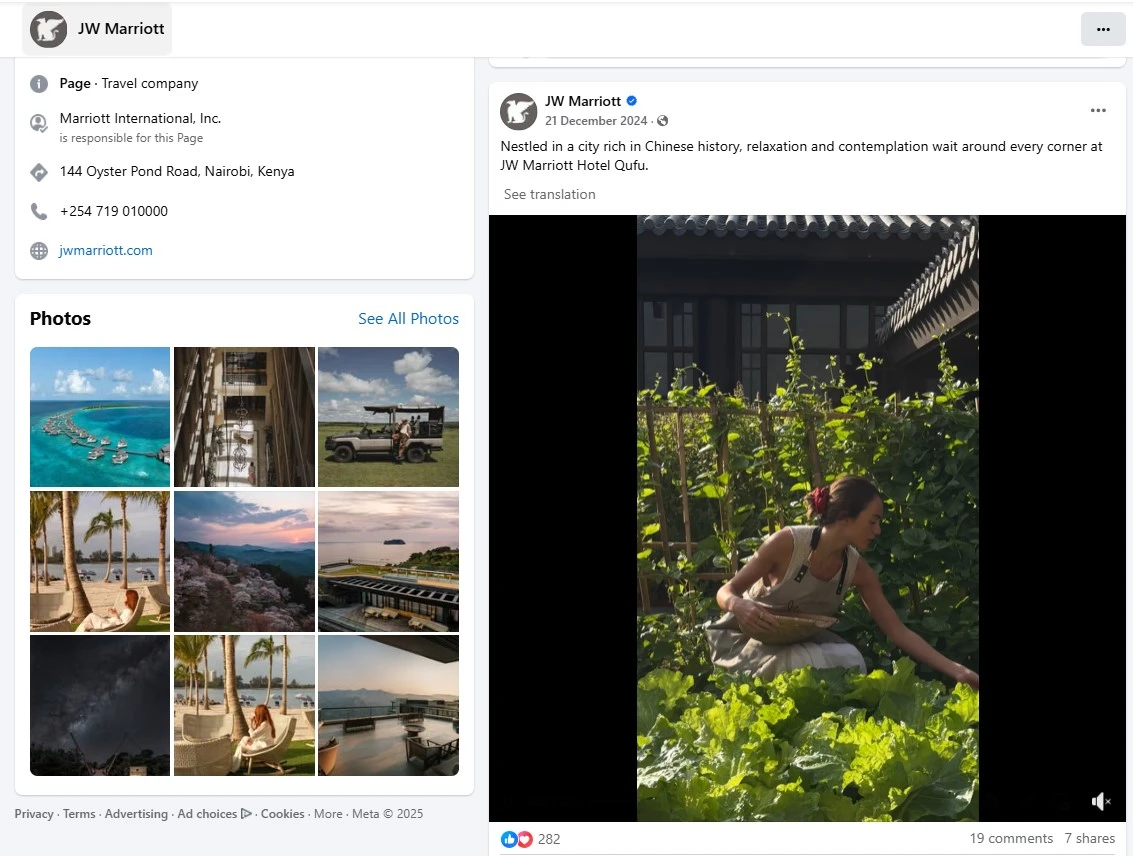 How about influencer marketing? If you think influencers are just for fashion brands, think again. Hotels partnering with travel influencers see a huge amount increase in direct bookings because their audience trusts recommendations over traditional ads.
Take The Ritz-Carlton, Maldives, for example. Instead of running generic ads, they invited luxury travel influencers for an exclusive stay. The result? Millions of organic impressions and a spike in high-value bookings from travelers wanting the same experience.
How about influencer marketing? If you think influencers are just for fashion brands, think again. Hotels partnering with travel influencers see a huge amount increase in direct bookings because their audience trusts recommendations over traditional ads.
Take The Ritz-Carlton, Maldives, for example. Instead of running generic ads, they invited luxury travel influencers for an exclusive stay. The result? Millions of organic impressions and a spike in high-value bookings from travelers wanting the same experience.
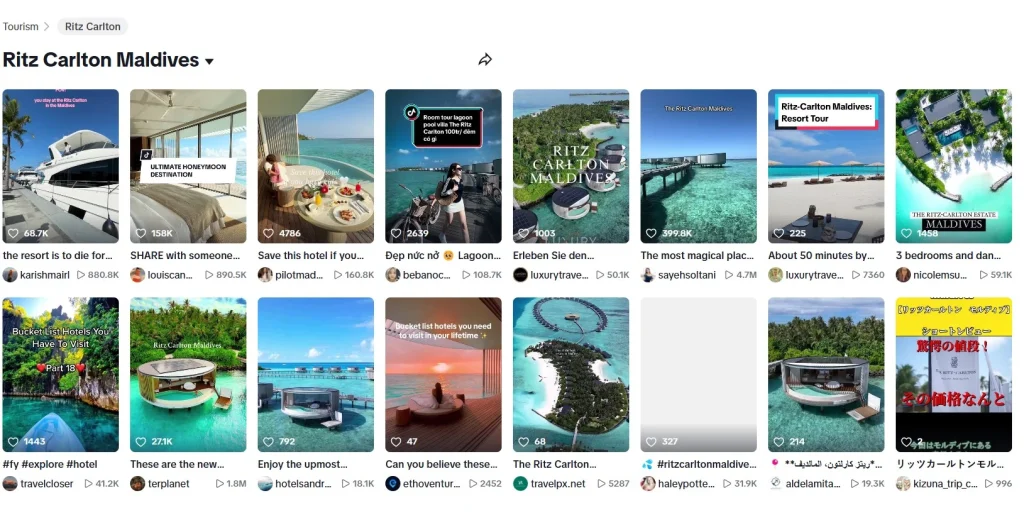 For smaller hotels, micro-influencers (those with 10K-100K followers) offer an affordable way to tap into niche, engaged audiences. Instead of offering hefty payments, many hotels exchange free stays for content, making influencer marketing one of the highest-ROI strategies in hospitality.
For smaller hotels, micro-influencers (those with 10K-100K followers) offer an affordable way to tap into niche, engaged audiences. Instead of offering hefty payments, many hotels exchange free stays for content, making influencer marketing one of the highest-ROI strategies in hospitality.
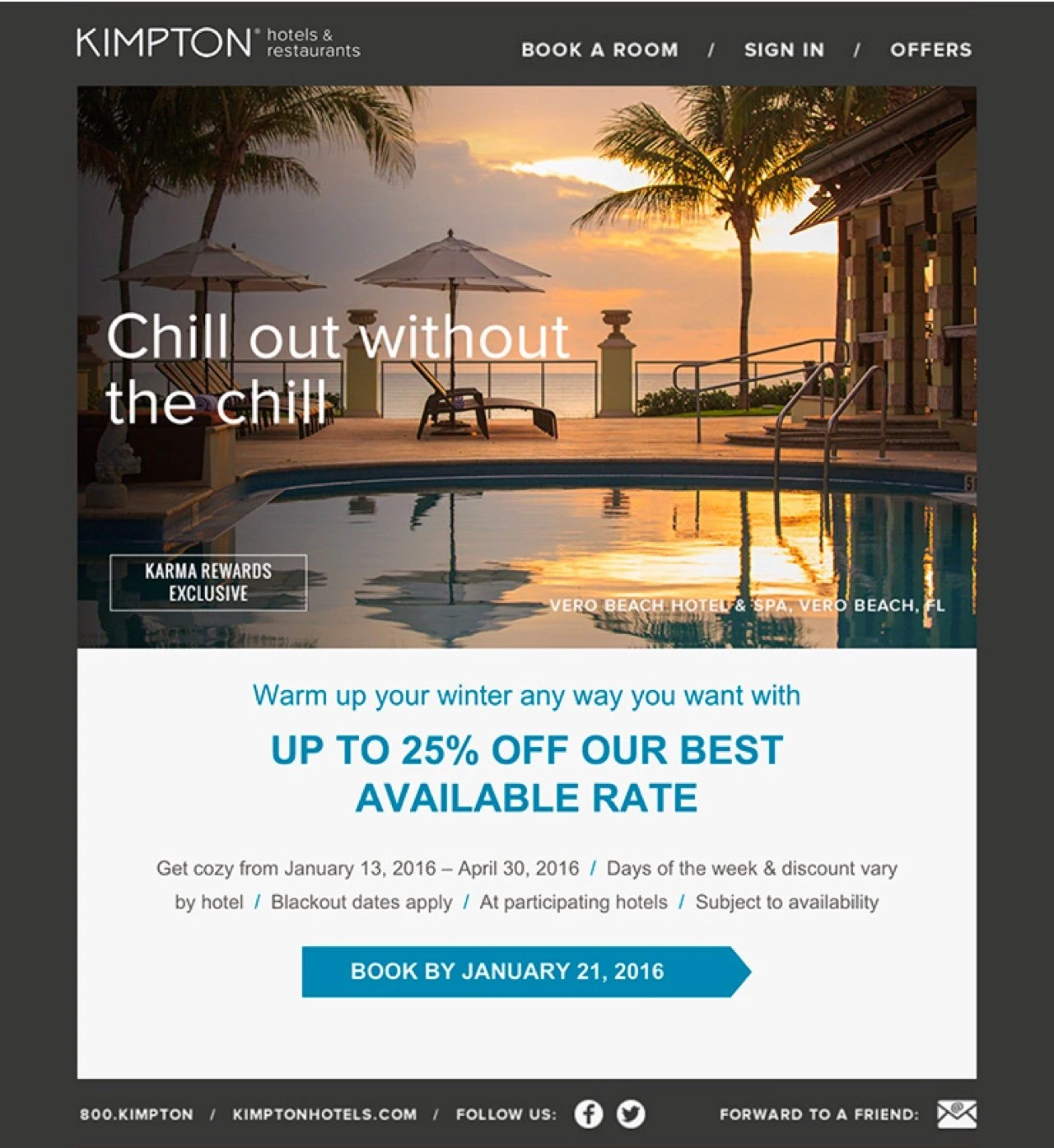 A well-structured email funnel guides potential guests through the booking journey and keeps past guests engaged. Here’s how to use email effectively:
A well-structured email funnel guides potential guests through the booking journey and keeps past guests engaged. Here’s how to use email effectively:
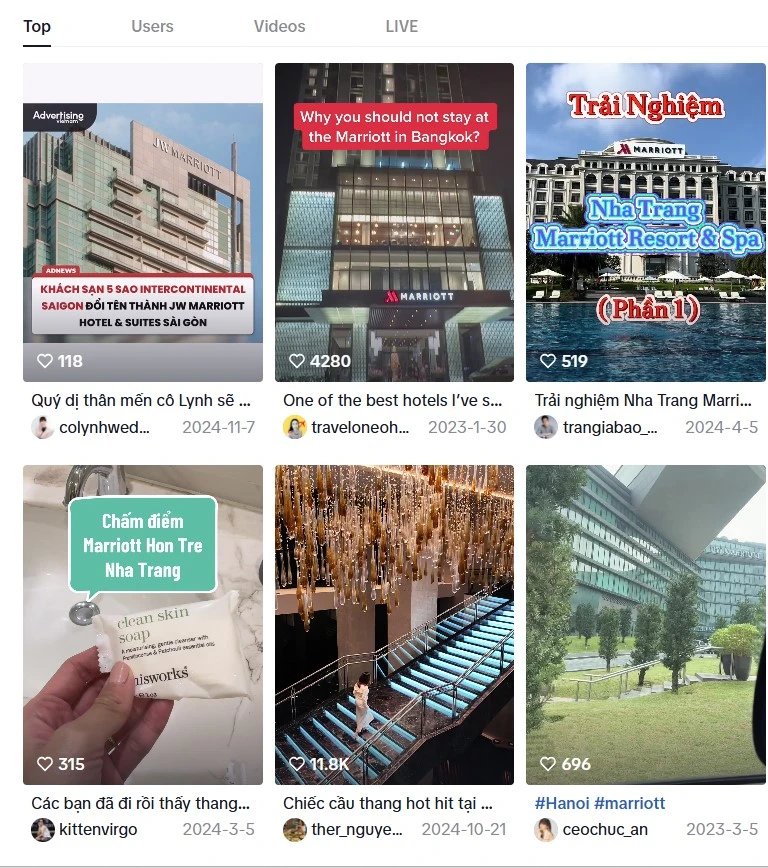 Virtual tours take things a step further by allowing travelers to experience the hotel before they book. With a considerable amount of travelers preferring hotels that offer virtual tours, interactive 360-degree videos give guests a realistic preview of rooms, amenities, and surroundings. This is particularly effective for luxury hotels, resorts, and unique accommodations, where ambiance and experience are key selling points.
Virtual tours take things a step further by allowing travelers to experience the hotel before they book. With a considerable amount of travelers preferring hotels that offer virtual tours, interactive 360-degree videos give guests a realistic preview of rooms, amenities, and surroundings. This is particularly effective for luxury hotels, resorts, and unique accommodations, where ambiance and experience are key selling points.
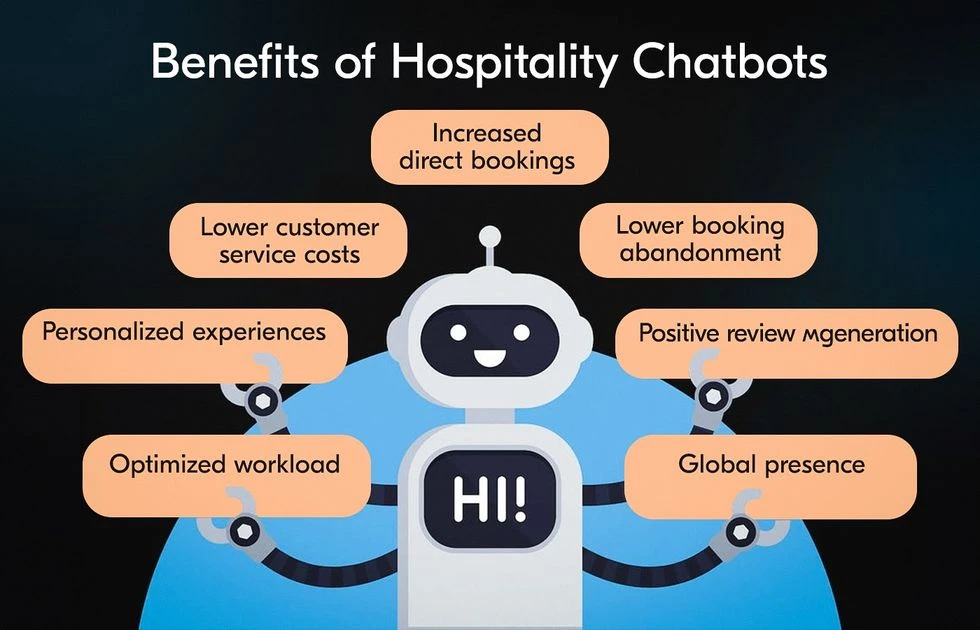


Understanding the Hotel Digital Marketing Ecosystem
Travelers are more tech-savvy than ever, with 83% preferring to research their trips online before booking . If your hotel or resort isn’t showing up at the right place, at the right time, you’re invisible. So, what exactly does the hotel digital marketing ecosystem look like? Think of it as a multi-channel battlefield where hotels and resorts compete for attention, clicks, and bookings. It’s not just about having a website; it’s about using the right mix of digital channels to stay ahead. To thrive in this landscape, you need to master the core pillars of hotel digital marketing below:| Pillars | Definition |
| SEO | Search Engine Optimization (SEO) helps hotels rank higher on Google and other search engines, making it easier for potential guests to find and book directly from the hotel website marketing. This includes optimizing keywords, improving website speed, and creating valuable content. |
| Paid Ads | Paid advertising, such as Google Hotel Ads, Facebook Ads, and Meta Ads, allows hotels/resorts to reach travelers actively searching for accommodations. It helps increase visibility, drive direct bookings, and reduce dependence on OTAs. |
| Social Media | Social media platforms like Instagram, TikTok, and Facebook are essential for showcasing hotel experiences, engaging with travelers, and leveraging influencer marketing for hotel/resorts to attract new guests. |
| Email & CRM | Email marketing and Customer Relationship Management (CRM) help hotels/resorts nurture relationships with past and potential guests. Automated emails for booking confirmations, personalized offers, and loyalty programs encourage repeat stays and boost guest satisfaction. |
| OTA | Online Travel Agencies (OTAs) like Booking.com, Expedia, and Agoda provide massive exposure for hotels/resorts, driving bookings through third-party platforms. While they charge commissions, a strong OTA strategy helps maximize occupancy and attract new guests. |
Building a High-Converting Hotel Website
Your website isn’t just a digital brochure—it’s your most powerful booking engine. According to Google, with 79% of travelers booking on mobile devices and 75% of users judging a hotel’s credibility based on its website, a poorly designed site could be costing you thousands in lost revenue. A high-converting hotel website should be visually stunning, easy to navigate, and optimized for seamless bookings. According to Hotel Benchmark, speed and responsiveness are non-negotiable—if your site takes longer than 4 seconds to load, 40% of visitors will leave. Mobile-first design is also critical, ensuring guests can book effortlessly from any device. Below is the result of page speed of one the most famous hotel chain in the world: Beyond functionality, your website should be built for conversion. Clear CTAs (Call-to-Actions), high-quality visuals, and compelling copy make a significant impact on a guest’s decision to book. Adding features like real-time availability, dynamic pricing, and guest testimonials enhances trust and encourages direct bookings.
At the core, a high-converting hotel website is more than just aesthetics—it’s about creating a frictionless, engaging, and conversion-focused experience that turns visitors into paying guests.
Beyond functionality, your website should be built for conversion. Clear CTAs (Call-to-Actions), high-quality visuals, and compelling copy make a significant impact on a guest’s decision to book. Adding features like real-time availability, dynamic pricing, and guest testimonials enhances trust and encourages direct bookings.
At the core, a high-converting hotel website is more than just aesthetics—it’s about creating a frictionless, engaging, and conversion-focused experience that turns visitors into paying guests.
Search Engine Optimization (SEO) for Hotels
If your hotel isn’t showing up on the first page of Google, you’re practically invisible to potential guests. Did you know that 75% of users never scroll past the first page? That’s why SEO for hotels is one of the most cost-effective ways to drive sustainable, direct traffic and bookings Let’s take a simple example. A strong SEO strategy ensures that when travelers search for "best hotels in [your city]", your hotel appears above competitors and OTAs (Online Travel Agencies). Below are some hotels that did really well in local SEO: But ranking high on Google isn’t just about stuffing keywords—it requires a combination of technical optimization, high-quality content, and a great user experience. Let’s see key components below:
But ranking high on Google isn’t just about stuffing keywords—it requires a combination of technical optimization, high-quality content, and a great user experience. Let’s see key components below:
| Key Pillars | How it works |
| Local SEO & GMB |
|
| Onpage SEO |
|
|
|
| Technical SEO |
|
| Off-Page SEO |
|
 Have you ever wondered how you can leverage SEO to boost direct booking to your website? Learn more at SEO300 Case Studies now! SEO300 is a digital agency established with a view to improving online presences of resorts and hotels in Vietnam. It is ranked Top 3 SEO Agencies by Goodfirms.
Have you ever wondered how you can leverage SEO to boost direct booking to your website? Learn more at SEO300 Case Studies now! SEO300 is a digital agency established with a view to improving online presences of resorts and hotels in Vietnam. It is ranked Top 3 SEO Agencies by Goodfirms.
Master the Art of Paid Advertising
Paid advertising is the fastest way to drive direct bookings and reduce dependence on OTAs. With 65% of hotel bookings starting on metasearch, running strategic ads ensures your hotel appears before competitors when travelers are searching. Google Hotel Ads, Search Ads, and Display Ads are among the most effective options, allowing hotels to target high-intent travelers actively looking for accommodations. A well-optimized Google Ads campaign can increase direct bookings by a significant percent, making it a cost-effective alternative to paying OTA commissions .
Budget allocation is crucial. For example, if the cost-per-click (CPC) for “luxury hotel in Paris” is $3, and the average booking value is $500, even a 2% conversion rate results in a 333% return on ad spend (ROAS). Similarly, retargeting ads, which remind users who visited the website but didn’t book, have 10x higher conversion rates than regular display ads, making them an essential strategy for recapturing lost bookings.
Google Hotel Ads, Search Ads, and Display Ads are among the most effective options, allowing hotels to target high-intent travelers actively looking for accommodations. A well-optimized Google Ads campaign can increase direct bookings by a significant percent, making it a cost-effective alternative to paying OTA commissions .
Budget allocation is crucial. For example, if the cost-per-click (CPC) for “luxury hotel in Paris” is $3, and the average booking value is $500, even a 2% conversion rate results in a 333% return on ad spend (ROAS). Similarly, retargeting ads, which remind users who visited the website but didn’t book, have 10x higher conversion rates than regular display ads, making them an essential strategy for recapturing lost bookings.
H2: Win with Hotel Social Media Marketing
Let’s be real—travelers aren’t just searching for hotels on Google. They’re scrolling through Instagram, TikTok, and Facebook, looking for inspiration. In fact, 60% of travelers use social media to research destinations, and 40% book a hotel after seeing it on social platforms, according to Winsavvy. If your hotel isn’t showing up in their feeds, you’re missing out on a massive opportunity. Instead of just posting polished promotional hotel content marketing, focus on authentic, engaging content that sparks curiosity. Travelers want to see real experiences, not just marketing fluff. Here’s how to make it happen:- Leverage User-Generated Content (UGC) – Guests trust other guests. Encourage visitors to tag your hotel in their posts and reshare their content. A simple repost of a guest’s sunset balcony view can be more powerful than a paid ad.
- Create Short-Form Video Content – TikTok and Instagram Reels are the new travel brochures. Hotels that use short, engaging video content get 2x more engagement than those that don’t.. Try room tours, behind-the-scenes clips, or local recommendations.
- Go Beyond Hotel Features – Don’t just showcase your rooms—showcase experiences. What’s nearby? What’s unique about your location? A boutique hotel in Bali, for example, could highlight hidden waterfalls, cultural spots, and foodie experiences to attract adventure travelers.
 How about influencer marketing? If you think influencers are just for fashion brands, think again. Hotels partnering with travel influencers see a huge amount increase in direct bookings because their audience trusts recommendations over traditional ads.
Take The Ritz-Carlton, Maldives, for example. Instead of running generic ads, they invited luxury travel influencers for an exclusive stay. The result? Millions of organic impressions and a spike in high-value bookings from travelers wanting the same experience.
How about influencer marketing? If you think influencers are just for fashion brands, think again. Hotels partnering with travel influencers see a huge amount increase in direct bookings because their audience trusts recommendations over traditional ads.
Take The Ritz-Carlton, Maldives, for example. Instead of running generic ads, they invited luxury travel influencers for an exclusive stay. The result? Millions of organic impressions and a spike in high-value bookings from travelers wanting the same experience.
 For smaller hotels, micro-influencers (those with 10K-100K followers) offer an affordable way to tap into niche, engaged audiences. Instead of offering hefty payments, many hotels exchange free stays for content, making influencer marketing one of the highest-ROI strategies in hospitality.
For smaller hotels, micro-influencers (those with 10K-100K followers) offer an affordable way to tap into niche, engaged audiences. Instead of offering hefty payments, many hotels exchange free stays for content, making influencer marketing one of the highest-ROI strategies in hospitality.
Email & CRM: Personalization that Converts
Most hotel emails go straight to the trash because they feel generic and spammy. But when done right, email marketing for hotels is a powerhouse for driving repeat bookings and guest loyalty. In fact, repeat customers spend 67% more than first-time visitors, making personalized email campaigns one of the most cost-effective ways to increase revenue. Below is the email marketing sample from Kimpton hotel: A well-structured email funnel guides potential guests through the booking journey and keeps past guests engaged. Here’s how to use email effectively:
A well-structured email funnel guides potential guests through the booking journey and keeps past guests engaged. Here’s how to use email effectively:
- Pre-Stay Emails: Once a guest books, send a personalized welcome email with details about their stay, local recommendations, and upgrade options..
- Abandoned Booking Recovery: 52% of travelers abandon their booking mid-process, often due to distractions or price comparisons.
- Loyalty & Post-Stay Campaigns: The best hotels don’t just market to new guests—they keep past guests coming back. Sending personalized offers, birthday discounts, and VIP deals can increase repeat stays.
- Special Promotions & Seasonal Offers: Instead of blasting generic sales emails, segment your audience. A luxury guest should receive exclusive spa retreat deals, while a budget traveler might get a "stay 3 nights, get 1 free" promo
Online Travel Agencies (OTAs) & Reputation Management
Love them or hate them, OTAs like Booking.com, Expedia, and Agoda dominate the hotel booking space, accounting for 43% of global hotel reservations. While these platforms offer massive visibility, they also come with high commission fees—typically ranging from 15% to 30% per booking. The challenge for hotels? Leveraging OTAs for exposure while driving more direct bookings to increase profitability. A strategic approach to OTAs means optimizing listings with high-quality images, compelling descriptions, and competitive pricing. Hotels that invest in OTA optimization see higher conversion rates compared to those with incomplete profiles. Additionally, offering direct booking perks—like free breakfast or exclusive discounts—can encourage travelers to book directly on the hotel’s website. Equally important is reputation management, as 93% of travelers say online reviews influence their booking decisions. Negative reviews can significantly impact a hotel’s reputation, making proactive review management essential. Hotels that respond to both positive and negative reviews within 24 hours see a 12% increase in bookings on average. A simple acknowledgment of guest feedback, offering solutions to concerns, and maintaining a professional tone can turn a dissatisfied guest into a returning customer. Take the example of a four-star resort in Bali, which saw a 30% increase in bookings after implementing an aggressive review response strategy. By engaging with every review, addressing concerns, and highlighting positive experiences, they improved their OTA ranking and built stronger guest trust. In today’s competitive hospitality landscape, OTAs are a necessary tool for visibility, but they shouldn’t be the sole source of bookings. Hotels that combine smart OTA strategies with strong reputation management can maximize reach while maintaining brand control and profitability.Leveraging Hotel Video Marketing & Virtual Tours
A picture may be worth a thousand words, but a video can be worth thousands of bookings. Whether it’s a stunning cinematic hotel tour, behind-the-scenes footage, or guest testimonials, video content brings your hotel experience to life in a way static images simply can’t. Short-form videos, like those on TikTok, Instagram Reels, and YouTube Shorts, are changing the game. Hotels that incorporate engaging video content see 2x more engagement on social media than those relying solely on photos. A quick 30-second room tour or a "day in the life" at your resort can instantly attract potential guests. Here is how Marriot leverage video to publish on Tiktok Virtual tours take things a step further by allowing travelers to experience the hotel before they book. With a considerable amount of travelers preferring hotels that offer virtual tours, interactive 360-degree videos give guests a realistic preview of rooms, amenities, and surroundings. This is particularly effective for luxury hotels, resorts, and unique accommodations, where ambiance and experience are key selling points.
Virtual tours take things a step further by allowing travelers to experience the hotel before they book. With a considerable amount of travelers preferring hotels that offer virtual tours, interactive 360-degree videos give guests a realistic preview of rooms, amenities, and surroundings. This is particularly effective for luxury hotels, resorts, and unique accommodations, where ambiance and experience are key selling points.
Performance Analytics & Measuring Success
So, you’ve launched your hotel digital marketing strategy—great! But how do you know if it’s actually working? Guessing won’t cut it. Without data, you’re just throwing money into the void and hoping for the best.- Forget vanity metrics like “likes” and “followers.” If you’re serious about boosting bookings and revenue, focus on KPIs that actually impact your bottom line
- Website Traffic & Conversion Rate – How many people visit your site, and more importantly, how many actually book? A high traffic volume but low conversion rate means something’s off—maybe your site is too slow, the booking process is clunky, or your pricing isn’t competitive.
- Direct Bookings vs. OTA Bookings – You want more guests booking directly rather than through OTAs (because who wants to give away 15-30% in commissions?). If OTAs are dominating, maybe it’s time to offer exclusive perks for direct bookings or improve your website’s booking flow.
- Return on Ad Spend (ROAS) – Are your Google Ads, Facebook Ads, and Meta Ads actually bringing in bookings, or are they just burning through your budget? A simple formula:
- ROAS = Revenue from ads / Cost of ads
- If you spend $1,000 on ads and make $5,000 in bookings, your ROAS is 5X. Solid.
- If it’s below 3X, time to tweak your targeting and creatives.
- Abandoned Booking Rate – Many of travelers start booking but don’t finish. Don’t let this situation happen! If your abandoned booking rate is high, consider retargeting ads, follow-up emails with discounts, or simplifying the checkout process.
| Situation | Solution |
| Low direct booking | Run a limited-time offer for website-only reservations |
| High ad spend, low ROAS | Check your booking process—reduce unnecessary steps and ensure pricing is transparent |
| Guests abandoning bookings | Use automated follow-up emails or remarketing ads to remind them why they should stay with you. |
Future Trends in Resort & Hotel Digital Marketing
The way travelers book hotels and resorts is changing fast, and if you're not keeping up, you’re falling behind. With new technology, shifting guest expectations, and evolving booking behaviors, hotels that adapt early will dominate the market. So, what’s next in hotel digital marketing? Here’s a peek into the future—and how you can stay ahead.1. AI & Chatbots: The 24/7 Concierge
Travelers want instant answers, that’s why many hotel guests prefer using AI-powered chatbots over waiting for a human response. AI-driven chatbots can handle reservations, answer FAQs, and even upsell services, all while reducing workload for your staff. If your hotel and resort still relies on slow email responses, you’re already losing potential guests.
2. Voice Search & Smart Assistants
More travelers are asking Siri, Alexa, or Google things like "Best boutique hotel near me" instead of typing it. In fact, 50% of all online searches will be voice-based by 2025. If your hotel website isn’t optimized for conversational keywords and voice search, you’ll miss out on a huge chunk of bookings.
